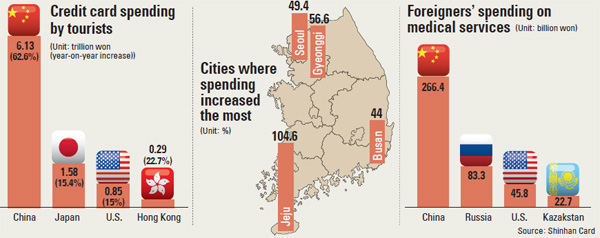Tourists spend big on credit cards

And the foreigners visiting Korea have led to an increase in credit card spending. But it’s not just interest in culture and popular music that has led to increased spending in Korea. The growing interest in medical services including cosmetic surgery has also been encouraging foreigners to open their wallets.
A joint study by Shinhan Card and the Korea Culture and Information Service on foreigners’ credit card spending last year found that they had purchased nearly 11 trillion won ($10.1 billion) worth of goods and services.
The culture and information service is the statistics agency of the Ministry of Culture, Sports and Tourism.
According to the study released Thursday, credit card spending by foreigners last year in Korea increased 38.8 percent over the previous year to 10.9 trillion won. This is equivalent to 2.4 percent of the roughly 460 trillion won that Koreans spent last year.
Chinese were the biggest spenders, accounting for 56.3 percent of total credit card spending, while the Japanese trailed behind in second with 15.4 percent and Americans took up 7.8 percent.
Last year, Chinese tourists charged more than 6 trillion won on credit cards, a 62.6 percent year-on-year increase, one of the biggest among all nationalities. Spending by Japanese expanded 15.4 percent over 2013 to 1.07 trillion won.
But the sharpest year-on-year increase in spending came from Kazakhstan, which grew 110.7 percent. Kazakhstan ranks 17th in terms of the amount spent on credit cards, at 0.4 percent of the total.
According to the study, spending by Kazakhstanis significantly increased compared to 2013 because since July the Korean government has given citizens of Kazakhstan a visa exemption. The government’s effort to bring in medical tourists from the Central Asian country has also contributed to their rise in credit card spending.
While Chinese still hold the top spot for medical spending, including on plastic surgery and dermatology, the year-on-year increase in Kazakhstanis’ credit card spending in the area was twice as large as that of Chinese tourists.
Kazakhstanis spending on medical services surged 152.9 percent over 2013, while Chinese spending was up 71.3 percent.
The study also noted that one of the main reasons for the sharp increase in spending by visitors from China was because several regional airports - Yangyang in Gangwon province, Cheongju in North Chungcheong and Gimhae in South Gyeongsang - do not require Chinese tourists to obtain a visa if they are staying in the country for less than 72 hours.
The largest portion of credit card spending by tourists went toward shopping, followed by lodging, food and medical services.
Foreigners spent 5.2 trillion won on shopping last year, or 47.7 percent of the total spending of 7.9 trillion won. The amount spent on shopping was a 44.2 percent increase over 2013.
Spending on lodging was at 2.8 trillion won, up 34.1 percent compared to 2013. Food spending as at 860 billion won, and medical spending amounted to 500 billion won.
Chinese spent the most on shopping and hotels, at 64.8 percent of the total, followed by Americans with 7.3 percent and Japanese with 7.1 percent.
However, total spending by Japanese fell 24.4 percent year-on-year, partially due to their weakening currency.
The study said that the major increase in spending on medical services, which grew 51.3 percent year-on-year, was mostly due to aggressive promotions by local clinics and the government.
Chinese spent the most in this sector, at 266.4 billion won last year, making up 53 percent of the total. Russians spent the second most, at 83.3 billion won or 16.6 percent, and Americans spent 45.8 billion won, 9.1 percent of the total.
Among the Chinese, the most popular procedures were plastic surgery and skin treatment while Russians came to the country to get treatments for illnesses at general hospitals.
Other than the Kazakhstanis, Indonesians had the second largest year-on-year increase on medical spending, at 106.9 percent, followed by the United Arab Emirates with 91.2 percent.
By region, most credit card spending - 7.9 billion won or 72.8 percent of the total - was in Seoul. Foreigners spent the most in Jung District, where Myeongdong is located. That was followed by Garosugil in Gangnam, southern Seoul.
Gyeonggi had the second-most spending by foreigners, at 830 billion won followed, by Busan and Incheon.
BY LEE HO-JEONG [ojlee82@joongang.co.kr]










with the Korea JoongAng Daily
To write comments, please log in to one of the accounts.
Standards Board Policy (0/250자)